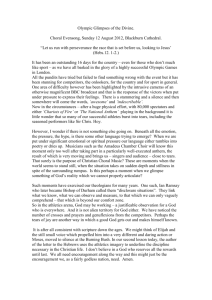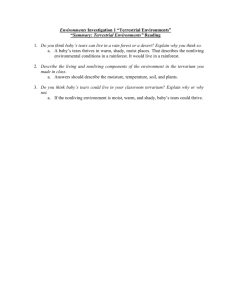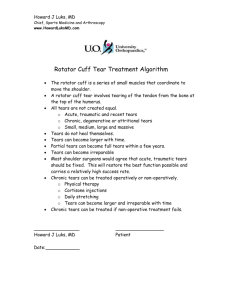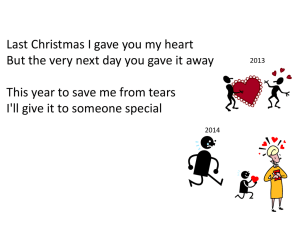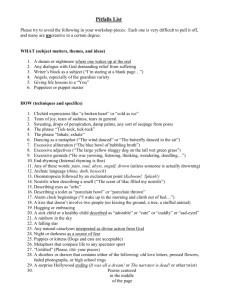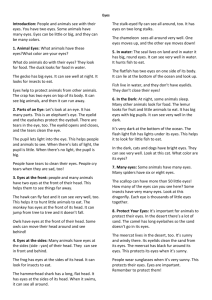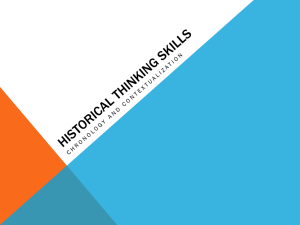Tears - C.G. Jung Society of Atlanta
advertisement
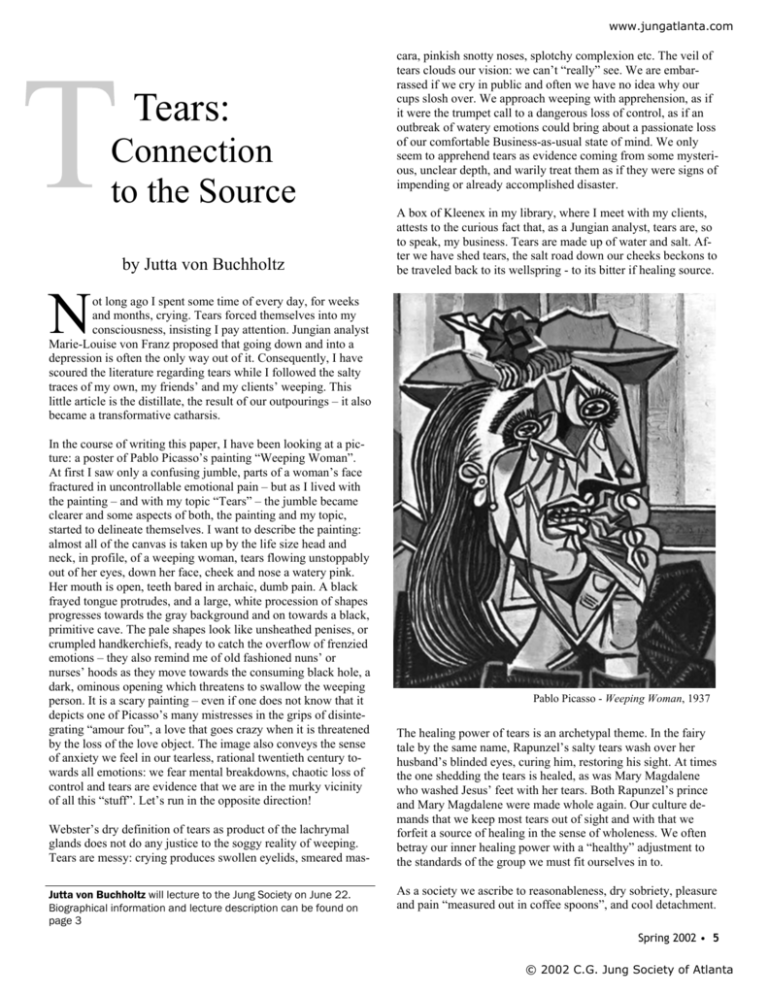
www.jungatlanta.com Tears: Connection to the Source by Jutta von Buchholtz cara, pinkish snotty noses, splotchy complexion etc. The veil of tears clouds our vision: we can’t “really” see. We are embarrassed if we cry in public and often we have no idea why our cups slosh over. We approach weeping with apprehension, as if it were the trumpet call to a dangerous loss of control, as if an outbreak of watery emotions could bring about a passionate loss of our comfortable Business-as-usual state of mind. We only seem to apprehend tears as evidence coming from some mysterious, unclear depth, and warily treat them as if they were signs of impending or already accomplished disaster. A box of Kleenex in my library, where I meet with my clients, attests to the curious fact that, as a Jungian analyst, tears are, so to speak, my business. Tears are made up of water and salt. After we have shed tears, the salt road down our cheeks beckons to be traveled back to its wellspring - to its bitter if healing source. N ot long ago I spent some time of every day, for weeks and months, crying. Tears forced themselves into my consciousness, insisting I pay attention. Jungian analyst Marie-Louise von Franz proposed that going down and into a depression is often the only way out of it. Consequently, I have scoured the literature regarding tears while I followed the salty traces of my own, my friends’ and my clients’ weeping. This little article is the distillate, the result of our outpourings – it also became a transformative catharsis. In the course of writing this paper, I have been looking at a picture: a poster of Pablo Picasso’s painting “Weeping Woman”. At first I saw only a confusing jumble, parts of a woman’s face fractured in uncontrollable emotional pain – but as I lived with the painting – and with my topic “Tears” – the jumble became clearer and some aspects of both, the painting and my topic, started to delineate themselves. I want to describe the painting: almost all of the canvas is taken up by the life size head and neck, in profile, of a weeping woman, tears flowing unstoppably out of her eyes, down her face, cheek and nose a watery pink. Her mouth is open, teeth bared in archaic, dumb pain. A black frayed tongue protrudes, and a large, white procession of shapes progresses towards the gray background and on towards a black, primitive cave. The pale shapes look like unsheathed penises, or crumpled handkerchiefs, ready to catch the overflow of frenzied emotions – they also remind me of old fashioned nuns’ or nurses’ hoods as they move towards the consuming black hole, a dark, ominous opening which threatens to swallow the weeping person. It is a scary painting – even if one does not know that it depicts one of Picasso’s many mistresses in the grips of disintegrating “amour fou”, a love that goes crazy when it is threatened by the loss of the love object. The image also conveys the sense of anxiety we feel in our tearless, rational twentieth century towards all emotions: we fear mental breakdowns, chaotic loss of control and tears are evidence that we are in the murky vicinity of all this “stuff”. Let’s run in the opposite direction! Webster’s dry definition of tears as product of the lachrymal glands does not do any justice to the soggy reality of weeping. Tears are messy: crying produces swollen eyelids, smeared mas- Jutta von Buchholtz will lecture to the Jung Society on June 22. Biographical information and lecture description can be found on page 3 Pablo Picasso - Weeping Woman, 1937 The healing power of tears is an archetypal theme. In the fairy tale by the same name, Rapunzel’s salty tears wash over her husband’s blinded eyes, curing him, restoring his sight. At times the one shedding the tears is healed, as was Mary Magdalene who washed Jesus’ feet with her tears. Both Rapunzel’s prince and Mary Magdalene were made whole again. Our culture demands that we keep most tears out of sight and with that we forfeit a source of healing in the sense of wholeness. We often betray our inner healing power with a “healthy” adjustment to the standards of the group we must fit ourselves in to. As a society we ascribe to reasonableness, dry sobriety, pleasure and pain “measured out in coffee spoons”, and cool detachment. Spring 2002 • 5 © 2002 C.G. Jung Society of Atlanta www.jungatlanta.com When does our environment permit our eyes to flow over? We allow babies to weep, although they are incapable of shedding tears until they are a few weeks old. People may cry at funerals – women avail themselves of the opportunity much more so than men. The brevity and matter of fact spirit of our funeral rites seems intended to stem the emotional outpouring of the bereaved rather than provide a safe container, a temenos, which would give space, dignity and respect to emotion. People are allowed to cry when their bodies are wounded, when there is concrete pain. Men are more bereft of emotional expression than women when it comes to cultural permission to cry: they make up the invisible, silent columns of tearless walking wounded. W e have a newcomer on our street: a single man who moved into our neighborhood a couple of years ago. After he had been here for almost a year his father died. A friend and I went to the funeral service. There were eulogies and testimonies to the deceased. His nephew, a handsome, bright young man delivered a speech. As he talked about his grandfather’s life, tears started to come and his words faltered. He acknowledged his state of disequilibrium but continued to talk movingly about his grandfather. His tears were not only evidence of the strong emotional ties between the two men, but as they spilled over, despite his efforts at control, all of us now belonged, mysteriously, with the grieving – sharing a profound and deeply human condition: no one was alone any longer; his healing tears bridged the distance between us and washed away the often unbearable sense of isolation and loneliness. Afterwards, a few weeks later, my neighbor and I talked about the funeral. He calmly commented on his nephew’s display of emotion as inappropriate, showing weakness and something that should have been prevented. Men have generally been condemned to a brittle, tearless life – women may cry, but often we carry the burden of our men’s unshed tears as well; we are considered weak when we allow our tears to flow. We are chided, even ridiculed for our emotional connectedness. Americans seldom welcome tears or the hurt and sadness we usually associate with them. Of all the emotions we are capable of, we split off a mass of them. We know we have a right to happiness – it says so in our Constitution. But where has our right to sadness and its wet companions gone? For that matter where are anger, worry, fear, envy, jealousy and all the other dark sisters and brothers when we look at all the guests invited to our brightly lit and well-adjusted lives? The collective allows for a severely limited emotional range – anything outside this “healthy”, narrow band of smiley-faced dryness may even be labeled pathological and must lead a secret life, closeted away. Psychologically this is a dangerous situation. Whatever lives in the closet – another word for the unconscious – develops a shadow life of it’s own, binds psychic energy, limits our creativity and is likely to erupt into our lives with archaic, usually malevolent force. Like the thirteenth fairy in “Sleeping Beauty”, inner figures only become dangerous when they are not invited. (Happens all the time to us when we are overlooked for invitations to parties, for promotions, in conversation etc.) Psychologically speaking, these inner figures become repressed or suppressed content, captives of a host of defense mechanisms. We know, for example, that unshed tears can lead to unmanageable hysteria or a soulless, arid wasteland in the psyche and dis- 6 • Jung Society of Atlanta Pablo Picasso - Weeping Woman, 1937 owned anger can readily turn into violent rage and aggression. I want to be clear that I am not advocating acting out: quite the contrary. By becoming conscious of our emotions our egos have the only chance of any control and humanizing interaction. On the level of diplomacy: if two countries break off communications, sadly, war is only too often the consequence. T he fountain of tears is grounded in wounds based on losses such as loss of innocence, persons, jobs, hopes, youth, health etc. But wounds also constitute openings of the surface. They provide a salty access road to what is more than skin deep. Jungians understand life through images – whether these images present themselves in dreams or during waking hours. These images, understood as symbols, establish a connection between consciousness, the house of the ego, and the deeper layers of the personal and/or collective unconscious, home of the complexes and archetypes. Libido, precious life energy, is rooted in and wells up from the unconscious. That is why we so need to have communications and creative interplay between these two psychic spheres. Much of our life energy is tied up with the shadow - personal as well as collective - and is out of eyesight. Following our individual trail of tears, allowing feelings to bubble up into consciousness, is the only chance we have of avoiding the destructive, shadowy aspect of emotions. We are afraid of emotionality in many Western societies, but especially so in the United States: it is messy and any messiness bugs us. Americans are well known for their penchant for disinfectants, antibiotics, bug sprays etc. Murky depths, things we do not understand, unpredictable confusion, mystery … most of us prefer not to be surprised or confused by and about most things. We ascribe to a risk free life, a relatively manageable, mess-free, easy, if passionless life. We have no patience for walking along any bluesy, dismal road. We insist on living almost exclusively on the sunny side of the street. It is not unusual that it can take © 2002 C.G. Jung Society of Atlanta www.jungatlanta.com many months and dozens of watery hours in analysis to shed the tears we were meant to shed but didn’t at an earlier time. Carl Jung thought modern man’s true illness was our loss of soul. Perhaps we can bind back split off parts of ourselves on the bitter salt road of our tears. This would mean inviting all of our emotions into consciousness. Senior Jungian Analyst Adolf Guggenbuhl-Craig once said to me that the function of analysis is to live life more passionately, with occasional periods of reflection! H aving focused primarily on tears that flow due to loss and sadness and on their connection to the neglected, dark wellspring of emotions in our arid lives … what about the much more acceptable tears of joy? While I was working on this paper, the Olympic Games were going on in Salt Lake City. Being swept up in the topic of tears, I noticed how much crying went on in very public places. The world watched strong young women and men shed tears of frustration and disappointment – yes, I could understand that because those were tears of loss of dreams and hopes. Stunningly often, though, these heroic, cool athletes wept – at times uncontrollably - AFTER they had won, at a peak point of happiness and accomplishment, at a time of being not only accepted, even venerated. Olympic medals were often awash in tears. One athlete said, “… something gave … in” about his tears. Another admitted to being “… convulsed by tears…” Many said they were “… overcome…” The flow of tears crossed national, sexual and racial boundaries. Why would anyone make a public display of very private emotions having arrived in heaven, so to speak? Can intense happiness become too painful and open the floodgates for tears? I became very aware of how close joy and sadness are and how intense experience of either, but especially if both come together, can spill over into tears. In our pain and sadness as well as in our joy, we feel intensely alive. I want to present a few examples – other than the Olympic Games - from my personal life, as well as from my consulting room, to amplify this insight. At times lovemaking has touched me so profoundly, that I melted down in tears afterwards. Nothing said or done in those moments of intensity and grace could hurt me. Other women have told me similar stories. Women have also talked to me about the moment of birth. It connected them to the greater rhythmical music of the universe. They became co-creators and they laughed and cried all at the same time. Pain and joy were united in a peak experience, life was whole, and tears and laughter could create an emotional rainbow for one fleeting moment. There was nothing to be afraid of, no danger, and no lonesomeness. Instead, there was a blissful sense of containment, and the pervasive knowledge of being part of a far greater mystery. Perhaps this experience of being at the fountain of wholeness concomitant with the acute consciousness, that it won’t last any time at all, that we are bound to have to leave heavenly paradise again, brings about this remarkable sense of passionate, intense aliveness – the bliss Joseph Campbell talks about which we must be on the search for. I understand this bliss to mean living our fullness, in blissful tears of joy as well as bitter ones of loss and sadness. Life may not be only about understanding, becoming conscious, – but/and also about living it passionately and fully, with tears of joy as well as sadness, as often as we can ■ Spring 2002 • 7 © 2002 C.G. Jung Society of Atlanta
